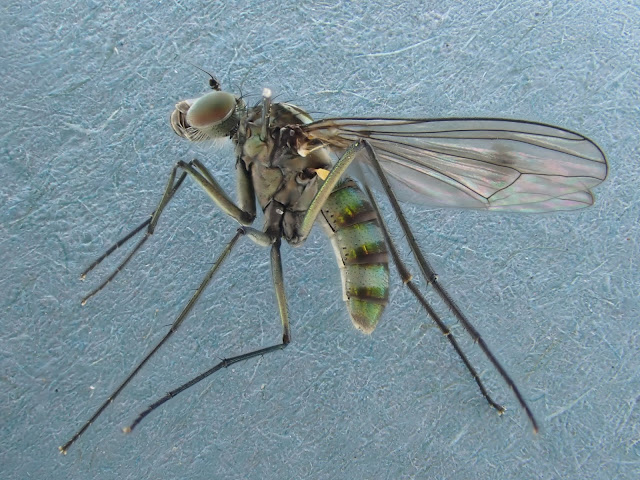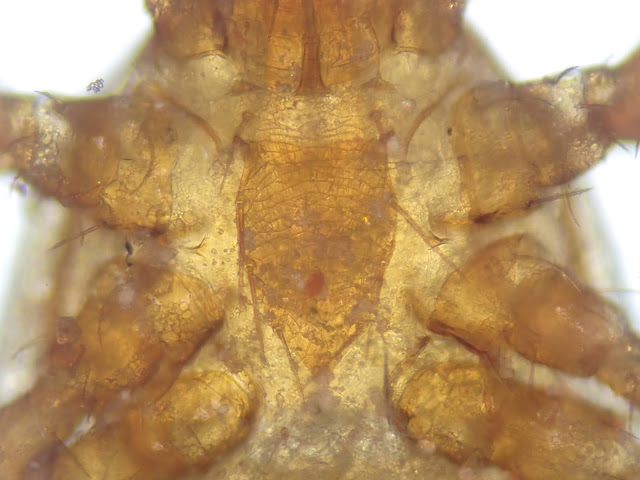Wow, has it really been two weeks since my last blogpost? Well yes it has, and never mind tutting and shaking your head like that, there's a reason for this. Everywhere up here is either flooded or completely sodden, the rain has been epic. I think we've had maybe four dryish days of which only two were windless and bright enough to stimulate a bit of insect activity. Naturally I had to make use of those days to get some outstanding exterior painting finished, so all in all I haven't seen more than a handful of spiders for weeks and almost every fly I've seen has been a gnat or midge. Not very inspiring! It's currently wet again and the wind chill is supposed to be dropping the temperatures to -9C tomorrow. So that's something to look forward to...
But enough of that doom and gloom rubbish, because my arachnid list has grown by one with the addition of a bee that was handed to me yesterday. Say what? I hear you cry. I shall explain.
My housemate brought me an almost dead bumblebee in a small container. It had flown through his window and disappeared behind a chair, whereupon he took his shoe off and smashed the bejeezus out of it. How it was still alive I have no idea. I explained that bees at this time of year are all pregnant queens, and that by killing this one he had in effect killed off an entire nest's worth. He just stared at me in a confused fashion, said I could keep the container, and walked off. Sheesh.
I was just about to give it the ethyl acetate treatment (the bee I mean, not my housemate) when I noticed a small dot leap from the bee and land upside down in my killing jar. Bees don't have fleas, and pseudoscorpions don't generally leap, so who was this tiny acrobat of a hitch-hiker?
Doubtless wondering where its bee has disappeared to
Aah, it's a mite. The only mites I know of that are associated with bees are the Varroa destructor mites. A quick look online showed me that firstly Varroa isn't associated with Bombus bees, and secondly that they look absolutely nothing like the beast I was puzzling over through the barrel of my microscope. Hmmm, I was suddenly intrigued!
More online digging quickly brought the phoretic mite Parasitellus fucorum to my attention. It seemed a good match and specialises in Bombus bees. Cool - but I bet there are several other species that turn up on bees. I dug around some more and realised there are several genera of mites that could occur on bumblebees. Arse. I asked the PSL Facebook Group for help finding a key and sat back awaiting a response. Nothing for the fifteen seconds I waited (I'm not great with being patient), so I dug some more and eventually found Mites of the subfamily Parasitinae (Mesostigmata: Parasitidae) in the British Isles. Turns out that there are lots of parasitic mites.
By now, young Finley the PSL whizzkid had responded. He said it would probably turn out to be Parasitellus fucorum (he obviously did the same quick internet trawl as I had!) and sent me a link to this key which, although American, covers the European species too. Big thanks to Finley, the key is ace. It was incredibly easy to start whittling my way through the initial 117 mite families down to easily manageable numbers and within about ten minutes I had arrived at just two options for my mite - Parasitus or Parasitellus. Cool beans, now we're getting somewhere! All I had to do was count the pairs of setae on the underside of the mite - more than 40 pairs and it was Parasitellus, less than 30 pairs and it was Parasitus. To make it easier for myself, I took a photo and enlarged it on the laptop screen, just so I didn't accidentally double count any 'dots'. How difficult could this be. A quick count of the area to the right of the midline came to about 30 dots - Parasitus.
 |
| Not very many at all, I reckon that's good for Parasitus |
I dived headlong into the Parasitus section of the key and soon discovered that there are only ten species in Britain and most of those aren't associated with bees. This would be a doddle, or so I thought. After quite some time I realised that none of the species described, including the ones not known to associate with bees, fully fitted my beast. It shared features with some, but not the full suite for any one species. Even given individual variation, I couldn't make it fit a species. I didn't believe for a second I had a hybrid mite. The key was written in 1980, it seemed entirely likely that new species of phoretic mite could have been discovered in Britain during the intervening 41 years, whether an overlooked native or a recent addition. I pondered whether such a 'recent addition' could have become widely established up and down the country by now. Tree Bee has managed it, maybe they brought in new mites with them? So was I looking at a recent arrival, one that wasn't in the key?
Of course, the most obvious conclusion was that I'd messed up in the family key, so I ran my mite through it once more. Yet again it dropped out at the Parasitus/Parasitellus option. Dropped out convincingly too. Maybe it was a Parasitellus? Time to count those dots again. This time I coloured them in as I went along, just to be doubly sure.

Oh, so that's a bit embarrassing! Allowing for the shallow depth of field rendering some setae invisible, I suddenly have about 40 dots which will clearly place this mite into Parasitellus not Parasitus. Fooksake, sometimes I really am an idiot! I turned to the relevant section and started again. This time there were a mere four species to contend with, all of which are associated with Bombus bees. This seemed promising. I scrolled down to the first species account and immediately recognised the illustrated palp armature and sternal plate as belonging to my beast - yes!!! Finally everything fitted properly and perfectly, all setae in the correct place, the tectum was a perfect match, the form of the enlarged inner bristles on the palps - everything!


Note the shape and relative sizes of the dorsal shields on my photo and in the illustration. It doesn't show up in my image, but the microsculpture shown in the illustration was clear to see through the microscope. Note also the two very large setae sticking out from the sides of the body. Most other species have these setae either shorter or pointing forwards. Also, there is a lot of uncovered dorsal area around and behind the posterior dorsal shield, most species have the shield covering a larger area.
This is the sternal shield on the underside of the mite. As soon as I clapped eyes on the illustration I knew it was a match for my mite's sternal shield. See how the side margin is concave below the shoulders and then fills out to nicely rounded sides - most other species don't show this. Coupled with the precise size and orientation of the structures above the shield, again very variable between the species, I was happy this was my species. But I had more features to crosscheck first.


This is the tectum, a pointed process that sits on the front of the head and varies in shape between age, sex and species of mite. I ought to have mentioned this earlier; mites have several different stages of development and mine was a deutonymph, which is essentially a sub-adult phase. Larger, older and more developed than a larva but not as well developed as an adult. Anyway, the shape of the tectum in this particular species is wholly different from that of any other deutonymph (or adult) and was another entirely confirmatory feature ticked off.


This was the one feature that I simply could not match up with any of the Parasitus species, the main reason I started over (twice...) and began to think I had a species that wasn't shown in the key. The lower of the three enlarged spines should be bifid or enlarged at the tip in Parasitus. With a squint I could see what looked like a couple of tiny notches in the lower surface, but clearly the spine itself was not bifid or enlarged in any way. However... move across to Parasitellus and suddenly it all falls into place beautifully.
And what species did I have? Parasitellus fucorum, which is what Finley told me it would be right before I even looked at a key. Bloody whizzkid, bless him.
Parasitellus fucorum is far and away the commonest of the phoretic mites to be found on Bombus bumblebees. It is widespread across much of Britain (though there are no records on NBN for any phoretic bee mites that I can see) as can be seen in this extract of the species account
 |
| Could be new for Skye though! |
So it's not a spider. And it's not a fly. But it is a species for my 2021 Challenge with The Ghost. At least I think it is. I can't recall now if he was allowing me all arachnids or just spiders. I suppose we'll just have to wait and see how far behind me he falls before he starts moving the goalposts to his own advantage once more...



















